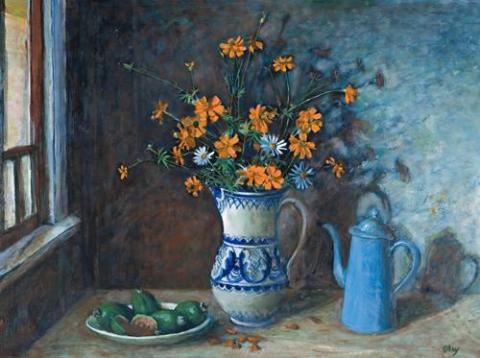STILL LIFE WITH FLOWERS IN A BLUE AND WHITE JUG , c.1975
Margaret Olley
oil on composition board
75.0 x 100.0 cm
signed lower right: Olley
Private collection, Brisbane (acquired c.1975)
Thence by descent, Private collection, Brisbane
Celebrating the fruits and hidden treasures of her own immediate world, Margaret Olley belongs to a prestigious tradition of still life painters - from Vermeer and Chardin to Cezanne and Morandi - who find inspiration, beauty and a rich spirit of humanity in the most familiar of subject matter. Within the history of Australian art moreover, she is regarded among the most admired and distinguished exponents of the genre; as James Gleeson asserts '...I can think of no other painter of the present time who orchestrates his or her themes with such richness as Margaret Olley. She is a symphonist among flower painters; a painter who calls upon the full resources of the modern palette to express her joy in the beauty of things.'1
Precisely fundamental to Olley's still-life and interior scenes is this principle of 'orchestration', gleaned directly from her experience of the theatre in 1948 when she assisted with painting the sets for Sam Hughes' productions of Shakespeare's Pericles and Cocteau's Orpheus (designed by Jean Bellette and Sidney Nolan respectively). Observing the actors being instructed to enter the stage and count twenty seconds before speaking their lines, the young artist soon came to appreciate the importance of creating space for oneself; as she fondly recalls, 'space is the secret of life...it is everything.'2 Thus, over the ensuing decades, Olley began to arrange the objects in her art as characters on stage - objects both commonplace and beautiful, shuffled this way and that, plunged into deep shadow or transformed by brilliant light.
Such is eloquently demonstrated in the present composition where the timeless perfection of the blue and white porcelain vase, the sensuousness of the pink-fleshed guava fruit and the pattern of vibrant orange daisies against the blue wall all serve to create an intimate, deeply personal drama for the eye and mind to explore. For indeed, as Barry Pearce aptly notes, '...to live with a Margaret Olley is to experience the transfiguration of a passionate, highly focused personality into art. In her paintings, the space surrounding each bowl of fruit, each vase of flowers, and through which the eye traverses a cacophony of surfaces such as patterned carpets, modulated walls, and cluttered tabletops, resounds with her presence. These are reflections of the things she loves, and which embellish the centre of how she prefers her existence to be.'3
1. Gleeson, J., 'Introduction', Margaret Olley, The Johnstone Gallery, Brisbane, 1964, n.p.
2. Margaret Olley cited in Pearce, B., Margaret Olley, The Art Gallery of New South Wales, Sydney, 1996, p.14
3. Pearce, B., 'Margaret Olley Retrospective', State of the Arts, Sydney, August-November 1996, p.5
Veronica Angelatos
